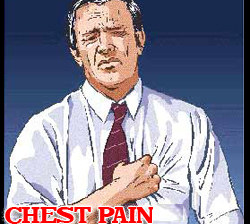Sudden chest pains are sign of angina
 Munich - It's not unusual for people to feel a pain directly behind their breastbone and think that it can't be their heart, since everyone knows that lies to the left side of the chest.
Munich - It's not unusual for people to feel a pain directly behind their breastbone and think that it can't be their heart, since everyone knows that lies to the left side of the chest.
It's not unusual, but it's wrong. While people think that the problem is in their airways, it is often actually their heart, says Helmut Gohlke of the German Cardiological Association.
The condition, known as angina, manifests itself as pain behind the breastbone. It's an illness where the blood flow to the heart muscle is restricted. If not recognized and treated in a timely manner, it can lead to a heart attack and death.
Circulatory disorders remain a major killer, but people ignore symptoms like angina, says Benny Levenson of an association for German residential cardiologists.
What are the symptoms of angina?
The pain behind the breastbone radiates mostly to the throat, the upper abdomen and the left arm. It is typically described as a dull, oppressive sensation of constriction, says Christian Hamm of the German Heart Association. Women often complain about lack of air. All those afflicted say the pain comes suddenly and in intervals, but does not last for days on end.
Steady forms of angina are prompted by exertion, like physical work or stress. "The pain usually disappears with rest," says Hamm.
Things are reversed in the more dangerous, unstable form of the disease. The pain appears out of nowhere, meaning there is a danger of a coming heart attack due to the complete blockage of a blood vessel.
Both forms require an immediate trip to the doctor.
Who is affected?
"Anyone whose oxygen supply is insufficient for their heart's needs gets angina," says Levenson. That means coronary vessels are blocked by arteriosclerosis and can't provide the heart with sufficient oxygen. But not everyone knows if they suffer from that symptom.
That's why it's important to know the risk factors, such as family history of the ailment. Anyone with an immediate relative who died of a circulatory problem has a 30 per cent risk, says Gohlke. If multiple relatives have had heart problems, then the risk doubles. Other risk factors include high cholesterol levels, high blood pressure, smoking and, above all else, diabetes.
How is a diagnosis made?
First, a family history is taken. "An experienced doctor can get a lot out of that," says Hamm. Since chest pains can also be caused by abdominal or spinal problems, it's important for the doctor to pay close attention. The next step is usually an exercise EKG test, which can determine the problem with an 80-per-cent degree of reliability.
"Then you run additional tests to find out if the heart is suffering from a lack of blood flow." That's done with nuclear medicine techniques, magnetic resonance imaging or ultrasound. A heart catheter might also be needed, says Gohlke. The tests show how widespread the problem is. (dpa)
